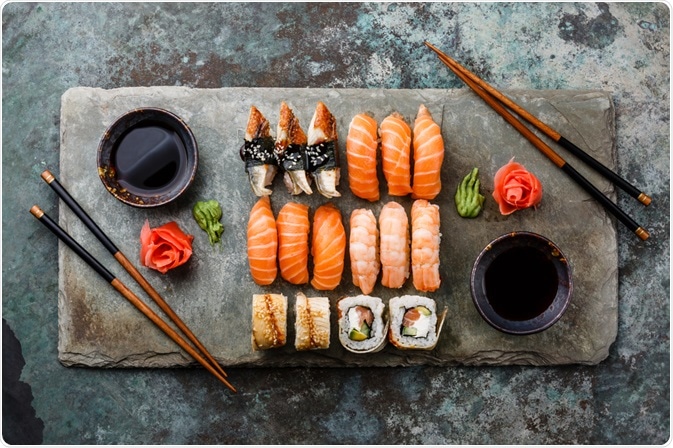In 2015, the World Health Organization (WHO) estimated 10% of people annually become ill around the globe from consuming contaminated food.

Image Credit: Natalia Lisovskaya/Shutterstock.com
Estimates also put the number of fatalities as a result of this contamination at 420,000 people annually.
Bacteria is present in all raw food, which are mostly benign. The pathogenic microbes can cause foodborne illnesses, in severe cases can cause lasting damage and in rare cases, death.
Raw fish is a notorious source of potential pathogenic parasites and bacteria due to the ability of bacteria to grow and thrive without destruction through the cooking process.
Below is discussed the different microbes that may exist in raw fish, their impact and how contamination can be avoided.
How microbes on raw fish cause disease
The Food and Drug Administration has guidelines to prevent contaminated raw fish from entering the market. Generally, food like sushi can be enjoyed without concern that it could be harboring harmful microbes.
However, each year there is a percentage of raw fish that fail to meet these standards and cause illness. Two of the most common types of microbes that can contaminate raw fish include Salmonella and Vibrio vulnificus.
A recent study found that around 10% of the raw seafood is imported into the US, and roughly 3% of the domestic raw seafood contains Salmonella which can cause food poisoning.
Vibrio vulnificus is mostly present in raw oysters, which is a bacteria that lives in warm seawater and can contaminate the oysters farmed from affected areas.
Recent figures from the Centers for Disease Control and Prevention estimate that around 1,252 people each year become infected with Vibrio vulnificus.
The Western Pacific region has the highest number of deaths related to foodborne microbes. The Chinese liver fluke (Clonorchis Sinensis), is particularly prevalent in this region.
The Chinese liver fluke can contaminate raw fish and is estimated to result in the infection of over 30,000 people each year in the region, with 20% of infections resulting in death.
Paragonimus species cause lung fluke disease and are prevalent in east Asia, infecting people through the consumption of infected raw crab or crawfish, causing infection of the lungs and in severe cases, the infection can spread to the central nervous system.
Raw fish from non-fresh water sources can contain bacteria that produce toxins causing Scombroid poisoning, these are thought to be comprised of histamines/histamine-like chemicals and can cause allergy-like symptoms and gastrointestinal distress within 10-90 minutes of ingestion.
Raw fish from tropical water can contain ciguatera, a toxin produced by Gambierdiscus which is associated with microalgae which are integrated into the food chain, eventually reaching humans.
The ciguatera toxin causes those infected to develop gastrointestinal, cardiovascular and neurological symptoms which may last for months.
Is sushi safe?
While several microbes can exist in raw fish, it does not mean raw fish are inedible. Strict regulations have been put in place through the knowledge of foodborne disease from consuming sushi.
If followed, these regulations protect the population from dangerous, and at times life-threatening infections. In the US, fish that is intended to be prepared raw, such as sushi, must be frozen at -4 degrees Fahrenheit for a total of seven days, or it must be kept at -31 degrees Fahrenheit for 15 hours.
This process of freezing the raw fish before it is consumed destroys any pathogens that may be harbored in the food.
Additionally, care should be taken when preparing fish at home to ensure that it is cooked properly and that any surface or utensil that comes into contact with the raw fish, such as chopping boards, surfaces, and knives, must be washed thoroughly to remove the harmful bacteria that is easily spread.
References:
- FDA. (2001). Fish and fisheries products: hazards and controls guidance (3rd ed.). Washington, DC: Food and Drug Administration, Centre for Food Safety and Applied Nutrition.
- Feldhusen, F. (2000). The role of seafood in bacterial foodborne diseases. Microbes and Infection, 2(13), 1651– 1660.
- Friedman, M. A., Fleming, L. E., Fernandez, M., Bienfang, P., Schrank, K., Dickey, R., Bottein, M. Y., Backer, L., Ayyar, R., Weisman, R., Watkins, S., Granade, R., & Reich, A. (2008). Ciguatera fish poisoning: treatment, prevention, and management. Marine drugs, 6(3), 456–479.
- Havelaar, A. H., Kirk, M. D., Torgerson, P. R., Gibb, H. J., Hald, T., Lake, R. J., ... & Speybroeck, N. (2015). World Health Organization global estimates and regional comparisons of the burden of foodborne disease in 2010. PLoS medicine, 12(12), e1001923.
- Stratta, P., & Badino, G. (2012). Scombroid poisoning. CMAJ : Canadian Medical Association journal journal de l'Association medicale canadienne, 184(6), 674.
- Vidaček, S., & Janči, T. (2016). Safety of fish products. In Regulating Safety of Traditional and Ethnic Foods (pp. 79-97). Academic Press.
Further Reading
Last Updated: Feb 18, 2020